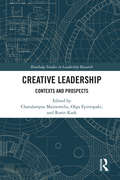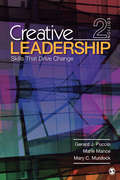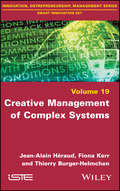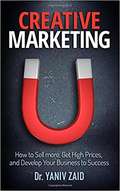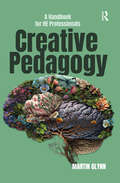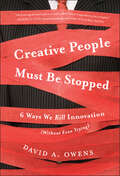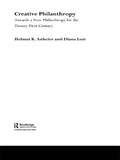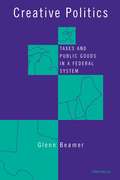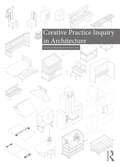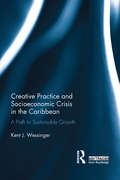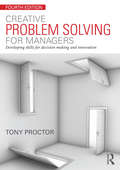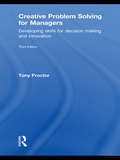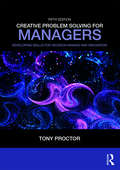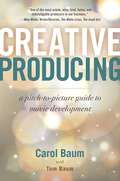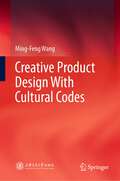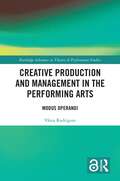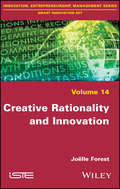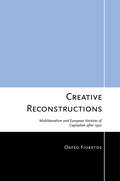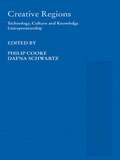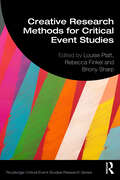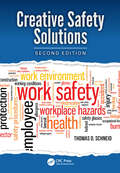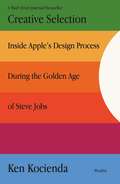- Table View
- List View
Creative Leadership: Contexts and Prospects (Routledge Studies in Leadership Research)
by Ronit Kark Charalampos Mainemelis Olga EpitropakiThere has never been a better time to study, practice, and experience creative leadership. In the fluid and turbulent economic and social environments of the 21st century, creative leadership has become a cardinal force in the creation and evolution of adaptive organizations. In the last two decades, organizational science has witnessed a rapid increase in the number of studies on the nature, skills, and processes of creative leadership. The resulting accumulated body of knowledge has remained for many years dispersed and fragmented across multiple strands of organizational research. This volume seeks to foster the cross-fertilization of scientific knowledge and insight by bringing together authoritative contributions from leading scholars whose work is located in different strands of creative leadership research. Creative Leadership: Contexts and Prospects builds upon a recently introduced multi-context framework that integrates metatheoretically three conceptualizations of creative leadership found in the extant literature: Facilitating employee creativity; Directing the materialization of a leader’s creative vision; and Integrating heterogeneous creative contributions. These three conceptualizations reflect essential differences in the enactment of creative leadership across various collaborative contexts of creative work, and they underlie the intellectual efforts of different research strands. The collection of chapters in Creative Leadership: Contexts and Prospects offers the latest thinking on creative leadership in facilitative, directive, and integrative contexts, and a stimulating set of ideas for crafting the next generation of nuanced theories and empirical studies in the field.
Creative Leadership: Skills That Drive Change
by Gerard J. Puccio Marie Mance Mary C. MurdockCreativity—today′s most important leadership skillSuccessful leadership today relies heavily on an individual′s ability to effectively respond to and proactively drive change—in short, to be creative. This book helps readers enhance their creative talents and employ these skills as a leader, providing a concrete set of principles and procedures based in creativity that, once internalized, will forever change how we lead.
Creative Management of Complex Systems
by Jean-Alain Heraud Fiona Kerr Thierry Burger-HelmchenThis book is a general presentation of complex systems, examined from the point of view of management. There is no standard formula to govern such systems, nor to effectively understand and respond to them. The interdisciplinary theory of self-organization is teeming with examples of living systems that can reorganize at a higher level of complexity when confronted with an external challenge of a certain magnitude. Modern businesses, considered as complex systems, ideally know how to flexibly and resiliently adapt to their environment, and also how to prepare for change via self-organization. Understanding sources of potential crisis is essential for leaders, though not all crises are necessarily bad news, as creative firms know how to respond to challenges through innovation: new products and markets, organizational learning for collective intelligence, and more.
Creative Marketing: How To Sell More, Get High Prices, and Develop Your Business to Success
by Yaniv Zaid<p>Do you want to jump start your business to reach amazing levels? <p>This book reveals the most innovative and successful tools for increasing your income, building your professional authority, creating and maintaining a community of customers, engaging in creative marketing, and maximizing your sales. Apply the skills and strategies you will gain here, and your business will soar! <p>Acquire all the skills you need for unprecedented business success! Learn all about: <p> <li>asking and getting high prices for your products and services, even in a "saturated" market <li>thinking creatively at all times, even in a competitive market <li>turning compliments into income and motivating people to act, even if they had not been planning to buy from you <li>creating a growing community around you and "educating" it to patronize you and not your competitors <li>marketing and selling differently and more effectively than do your competitors <li>making as many people as possible talk about you as much as possible, saying only good things <li>and more…</li> </p>
Creative Methods in Organizational Research (SAGE series in Management Research)
by Michael P BroussineWritten for the researcher who wants to inquire into organizational life in a creative way, this innovative book will equip readers with the tools to gather and analyze data using stories, poetry, art and theatre. Ideas are substantiated by reference to appropriate theory and throughout the reader is encouraged to reflect critically on the approach they have chosen and to be alert to ethical issues. Revealing case studies show how the research approaches covered in the book work in practice. Challenging readers to reassess what is possible when conducting research, Creative Methods in Organizational Research will enrich the research experiences of post graduates in the fields of organization studies, management and management education.
Creative Pedagogy: A Handbook for HE Professionals
by Martin GlynnThe ultimate toolkit for lecturers and practitioners in higher education aimed at developing creative pedagogy that will inspire and empower students. It demonstrates how creative teaching and learning methods can engage students and encourage them to be reflective and mindful, as well as enhancing their potential to build social and cultural capital, increase their employability prospects, social mobility and civic participation.It recognises that traditional teaching methods do not work for all learners and embraces contemporary ideas, innovative strategies and new technologies that can provide appropriate and accessible learning for students, enabling HE lecturers to challenge the status quo and expand their creative teaching skillset. Learning can become a co-construction between the lecturer and students with outcomes of increased retention in the classroom, more engagement in the learning, and more fun. This could be the start of doing things not only differently but more effectively.
Creative People Must Be Stopped: 6 Ways We Kill Innovation (Without Even Trying)
by David A. OwensA framework for overcoming the six types of innovation killers Everybody wants innovation--or do they? Creative People Must Be Stopped shows how individuals and organizations sabotage their own best intentions to encourage "outside the box" thinking. It shows that the antidote to this self-defeating behavior is to identify which of the six major types of constraints are hindering innovation: individual, group, organizational, industry-wide, societal, or technological. Once innovators and other leaders understand exactly which constraints are working against them and how to overcome them, they can create conditions that foster innovation instead of stopping it in its tracks. The author's model of constraints on innovation integrates insights from the vast literature on innovation with his own observations of hundreds of organizations. The book is filled with assessments, tools, and real-world examples. The author's research has been featured in the New York Times, Wall Street Journal, London Guardian and San Jose Mercury News, as well as on Fox News and on NPR's Marketplace Includes illustrative examples from leading organizations Offers a practical guide for bringing new ideas to fruition even within a previously rigid organizational culture This book gives people in organizations the conceptual framework and practical information they need to innovate successfully.
Creative Philanthropy: Toward a New Philanthropy for the Twenty-First Century
by Helmut K. Anheier Diana LeatPhilanthropy and endowed foundation are vitally important institutions of modern society, yet in recent years, they've faced new threats such as declining resources and questions of accountability and performance. To address these questions, individual philanthropists and foundation leaders have looked to strategic philanthropy to become more effective and efficient. This important book provides an overview of creative philanthropy along with an analysis of its theory and practice. The authors spell out the implications of their study for management and policy and provide readers with vital tools and techniques. Drawing on case study examples and incorporating sections on key questions and dilemmas, this revealing book covers: the philanthropic deficit finding a distinctive role to do more with less characteristics of the creative foundation beyond strategic philanthropy the strength of creative philanthropy developing creative foundations and philanthropic practices. Essential reading for all those who study or work in foundations, philanthropy and non-profit organizations, this volume clearly navigates a path through this significant yet highly complex subject area.
Creative Politics
by Glenn BeamerState legislators are constantly making tradeoffs between changing taxes and providing public services. Not only must they reconcile their own policy preferences with the preferences of their constituents, but they must consider the impact of actions taken by both the federal government and competing states. Glenn Beamer uses a series of in-depth case studies in eleven states to show how legislators made decisions dealing with taxation, economic development, education financing, and Medicaid. Beamer identifies six factors that influence legislators' decisions: accountability, dependability, equity, obscurability, and horizontal and vertical transferability. Within the context created by citizen demands, intergovernmental politics, policy histories, court interventions, and state constitutions, this study analyzes how legislators employ these principles to develop and enact policies. In addition to modeling state politics within the context of federalism, Creative Politics, reflecting the author's extensive interviews with legislators, is novel in its focus on politicians' views about public services, the strategies to finance them, and efforts to develop and maintain political support for them. This book will be of interest to students and scholars of political science, economics, and public administration, and, more specifically, of federalism, state politics and policy, and legislative decision-making.
Creative Power of Technology in Process Innovation
by James M. UtterbackThis chapter focuses on the chemical-based photography industry--where both product and process technology were key factors in eventual success--in its discussion of the power of innovation in the creation of an industry and a growing market.
Creative Practice Inquiry in Architecture
by Adam Sharr Ashley MasonThis collection introduces, illustrates, and advances fresh ideas about creative practice inquiry in architecture. It concerns architectural knowledge: how architects can use their distinctive skills, habits, and values to advance professional insight, and how such insights can be extended to make wider contributions to society, culture, and scholarship. It shows how architectural ways of knowing and working can be mobilised as tools for research. Collected here are a series of creative practices that emerge out of architecture and actively engage with other fields and methods reaching across the academic landscape. Architectural inquiries collected in this book probe matters that lie beyond the obvious expectations, the conventions, the default, of the discipline. Drawing, borrowing, adapting, dramatising, perhapsing, monstering, experimenting, cartooning—the tools and methods of each inquiry vary but they all share a common outward gaze, engaging architectural ways of knowing with other disciplines and practices including the arts, biological sciences, ethnography, and technology. Chapters gathered here offer insight not only into incipient modes and tools of architectural research, but emerging ethical, practical, and philosophical positions intimately tied to the creative practices involved. Setting-out the idea of creative practice inquiry in architecture, this innovative volume offers a lively and resourceful contribution to a growing body of work on design as research. It will be of interest to: students keen to pursue architectural ways of thinking and writing; practitioners who want to use their distinctive professional abilities to contribute to architectural and scholarly knowledge; and academics and doctoral candidates keen to engage with the burgeoning scholarly field of design research.
Creative Practice and Socioeconomic Crisis in the Caribbean: A path to sustainable growth
by Kent J. WessingerAlthough the world is saturated with extraordinary methods, innovation, and technology, the Caribbean seems to have been left behind in the sustainable growth of global development. While the majority of the world defines the Caribbean as "paradise," the reality of life for Afro-Caribbean culture is defined by an unrelenting hardship. This book comprehensively analyzes this phenomenon from a unique and intimate perspective in order to offer a viable pathway to sustainable growth. By examining the historic progression of the Caribbean region and the African culture within, the author explores the relationship between creative practice and socioeconomic crisis and questions whether limited access to environments that facilitate original and conceptual ideas correlates with socioeconomic crisis. The outcomes and methods of analysis developed in this book are a useful tool for other cultures or organizations seeking to diffuse socioeconomic crisis and implement a pathway of sustainable growth. This innovative book will be of great interest to students and scholars of cultural and sustainability studies, Caribbean and African Studies, as well as Development and Sustainable Development
Creative Problem Solving for Managers: Developing Skills for Decision Making and Innovation
by Tony ProctorStimulating and developing the creative potential of all members of an organization (not just those in the more traditionally creative functions such as design or research and development) is widely seen as contributing to performance and results. This textbook introduces ideas, skills and models to help students understanding how creative thinking can aid problem-solving. The latest edition of this well-regarded book brings the story up to date whilst retaining popular features such as case studies and case histories together with extensive diagrams, examples and thought-provoking questions. New to this edition are sections on thinking styles and types, creativity and its role in innovation, implementation, and software aids to creativity. This rounded textbook will continue to be an ideal resource for a range of courses and modules across the business school curriculum including problem-solving, strategic management, creativity and innovation management.
Creative Problem Solving for Managers: Developing Skills for Decision Making and Innovation
by Tony ProctorThe regularity with which the term 'solutions' is used in management speak suggests that management is largely about problem solving. To suggest that thinking creatively is a useful skill in solving a problem may be stating the obvious, but experience tells us that under pressure, managers tend to fall back on the 'tried and tested' rather than the new and creative. This text provides an essential introduction to the ideas and skills of solving problems creatively. It demonstrates: how and why people are blocked in their thinking how this impairs the creative problem solving process how creative problem solving techniques can help overcome these difficulties Theories of creative thinking are critically examined and utilised to explore the variety of techniques that can be employed to discover insights into difficult management problems. Using case studies and case histories together with extensive diagrams, examples and thought-provoking questions, Creative Problem Solving for Managers provides the most up-to-date and extensive approach to this important topic. This refreshing new edition will prove essential reading on the growing number of 'creativity management' classes springing up in business schools and will also be a helpful read on a range of other modules that require a creative mindset.
Creative Problem Solving for Managers: Developing Skills for Decision Making and Innovation
by Tony ProctorStimulating and developing the creative potential of all members of an organisation is widely seen as contributing to performance and results. This prestigious textbook provides a complete overview of the creative problem-solving process and its relevance to modern managers in the private and public sectors. It introduces ideas, skills and models to help students understand how creative thinking can aid problem solving, and how different techniques may help people who have different thinking and learning styles. This updated fifth edition includes fresh case studies, exercises and suggested reading, alongside extensive diagrams and thought-provoking questions. A new chapter considers the use of heuristics in decision-making situations faced by managers, and examines how aspects of creative problem solving can relate to such situations. It also introduces a complex in-tray exercise, which demonstrates how the conflicting demands on an individual manager can be considered in practice. Supporting PowerPoint slides for lecturers are available for each chapter. Creative Problem Solving for Managers will continue to be an ideal resource for undergraduate and postgraduate students studying problem solving, strategic management, creativity and innovation management, as well as managers looking to develop their decision-making abilities.
Creative Producing: A Pitch-to-Picture Guide to Movie Development
by Tom Baum Carol BaumGo behind the scenes with the producer of Father of the Bride to learn all the skills necessary to be a top Hollywood producer As former co-president of Dolly Parton's production company, Sandollar, and as a successful independent producer, Carol Baum is an expert in the art of film production. Creative Producing provides a crash course in the frequently misunderstood producer's role and the many skills needed to survive and thrive in Hollywood. Readers receive a master class in production––from pitching, script development, and packaging, to working with stars, directors, and difficult executives. Enhanced with behind-the-scenes stories from Baum's illustrious career, Creative Producing offers an intimate look behind the Hollywood curtain to give film students, cinephiles, aspiring executives, and industry insiders a must-have guide to understanding film development from successful pitch to hit picture.
Creative Product Design With Cultural Codes
by Ming-Feng WangThis book proposes new design and development models for local cultural and creative products, intended to improve the quality of these products and to preserve or enhance their local economic benefits. Building a knowledge base of design symbols and information gleaned from local history can be used to simplify the process of creative product design and increase the efficiency of product development. This book proposes a method for grasping the essential elements of symbols and culture so as to accelerate product development and capture the essence of culture in product design. In addition, it demonstrates that exhibitions applying scenario-oriented design can not only strengthen the representation of local culture, history and stories, but also support product consumption. As a result, the book offers a valuable asset for boosting the efficiency of creative product design and promoting the consumption of creative cultural products.
Creative Production and Management in the Performing Arts: Modus Operandi (Routledge Advances in Theatre & Performance Studies)
by Vânia RodriguesThis volume takes stock of the ways in which the regimes of artistic creation and production intersect, lending special attention to emergent discourses and work models of producing and managing theatre, dance, and performance – through the lenses of creative producers.This book suggests that social protection failures, longstanding institutional shortcomings, and the dilemmas of social and environmental sustainability are pushing arts management and production modi operandi towards a review of its expansionist assumptions and managerial hyper-productivist processes. By documenting singular ‘counter-management’ experiences in Portugal, Belgium, France, and Brazil, this study makes a strong claim for a reassessment of the role of producers and art managers as reflective practitioners and as pivotal elements towards more sustainable artistic practices.This study will be of great interest to students and scholars in theatre and performance studies, policymakers, and cultural professionals.
Creative Rationality and Innovation
by Joelle ForestThis book urges us to be creative in our way of thinking about innovation. Adopting an artificial perspective, the author emphasizes creative rationality: a form of thought that encourages knowledge crossing and invites an adventurous transgression. The question of how such a form of thought might be developed is addressed through a detailed examination of the educational system. The book frees itself from many of the myths that surround innovation, including the predominance of what the author calls the linear and hierarchical model.
Creative Reconstructions: Multilateralism and European Varieties of Capitalism after 1950 (Cornell Studies in Political Economy)
by Orfeo FioretosTwentieth-century Europe was an intense laboratory of capitalist experimentation. Confronted with economic booms and crises, technological revolutions, and economic globalization, Western Europe’s governments constantly explored alternative ways of managing domestic economic systems and international commerce. Bridging comparative and international political economy, Creative Reconstructions compellingly expands our understanding of the historic relationship between varieties of capitalism and international cooperation. Orfeo Fioretos’ pathbreaking analysis places multilateral institutions at the center of the study of capitalism. He highlights the role played by governments’ multilateral strategies in shaping the national trajectories of capitalism in Great Britain, France, and Germany. Fioretos shows that membership in international organizations such as the European Union and its precursors was an integral innovation in the domestic management of capitalism that came to play a central, if varied, role in shaping the evolution of modern market economies.Spanning six decades from the postwar period to the global crisis of 2008, Creative Reconstructions details the opportunities and constraints that multilateral engagements entailed for reforms in national financial, corporate governance, industrial relations, and innovation systems. In vivid analytical narratives, Fioretos shows how multilateral institutions served to reinforce and at times to undermine ambitious domestic reform programs. Creative Reconstructions deepens our understanding of modern capitalism in Europe and offers valuable lessons for regions beyond its borders.
Creative Regions: Technology, Culture and Knowledge Entrepreneurship (Regions and Cities)
by Philip Cooke Dafna SchwartzThis unique book focuses on regional creativity, analysing the different factors that can affect creativity and innovation process within regions in the knowledge economy. Approaching creativity from technological, organizational and regional viewpoints, it attempts to break down the influence of oppositional approaches and take account of multi-level interactions in economy and policy. The variety of papers presented looks at: how regions can be creative and competitive how research and development is outsourced and the scientific knowledge and technology transferred what types of technology based cultural activities can operate the relevant financing and development of knowledge entrepreneurship. Whilst many of these aspects are driven by market forces Creative Regions demonstrates that the regional and national public sectors have a significant role to play and is essential reading on how to generate a competitive advantage for regions in the knowledge economy in the global market.
Creative Research Methods for Critical Event Studies (Routledge Critical Event Studies Research Series.)
by Rebecca Finkel Louise Platt Briony SharpThis timely and innovative book offers an introduction to a range of creative methods, providing both empirical and conceptual guidance. Based upon existing empirical work and richly illustrated throughout, each chapter carefully examines creative methodology and/or methods within an event and festival context. International case studies are incorporated throughout, providing real-world examples of how these methods have been used in practice, as well as highlighting potential ethical issues. Each chapter includes a concise ‘how to’ set of guidelines to help researchers and students employ creative methods in their own work, as well as a series of ‘think points’ to help develop ethical practices. Chapters illustrate new pathways or lessons learned from research during the pandemic and other challenging landscapes.This significant volume offers festival and event researchers and students a different approach to their work that could result in better research, reaching hidden and marginalised groups.
Creative Research in Economics (Routledge Frontiers of Political Economy)
by Arnold WentzelResearchers are expected to produce original findings, yet nobody explains how original contributions are conceived in economics. Recently there have been calls for more creativity in economic research, yet there is no literature that explores creative research apart from collections of biographical essays. This book aims to address that gap, exploring the process of conceiving and generating ideas for interesting and original research contributions in economics (and potentially other social sciences too). Creative Research in Economics serves both a practical and theoretical purpose. Theoretically it presents a unique way of thinking about the nature of problems and questions in economics and the role of social science researchers in society. As such it offers an interesting way to think about the philosophy of science and methodology in economics, and how new ideas emerge in the discipline. Practically it develops techniques for finding interesting and original research contributions (as opposed to conventional data-gathering research). Whether you are a graduate student looking for that first interesting question, a novice researcher in search of fresh avenues for research after your PhD, or a seasoned academic looking to teach the philosophy and methodology of economics in more interesting ways, you will find this book of great use.
Creative Safety Solutions (Occupational Safety And Health Guide Ser. #18)
by Thomas D SchneidIn today's rapidly changing workplace, safety and loss prevention professionals cannot always "go by the book" for the answers to new and unique problems and issues. When there is no tried-and-true solution to a problem, safety and loss prevention professionals must think outside of the box of conventional solutions and develop new and creative sol
Creative Selection: Inside Apple's Design Process During the Golden Age of Steve Jobs
by Ken Kocienda* WALL STREET JOURNAL BESTSELLER *An insider's account of Apple's creative process during the golden years of Steve Jobs.Hundreds of millions of people use Apple products every day; several thousand work on Apple's campus in Cupertino, California; but only a handful sit at the drawing board. Creative Selection recounts the life of one of the few who worked behind the scenes, a highly-respected software engineer who worked in the final years of the Steve Jobs era—the Golden Age of Apple. Ken Kocienda offers an inside look at Apple’s creative process. For fifteen years, he was on the ground floor of the company as a specialist, directly responsible for experimenting with novel user interface concepts and writing powerful, easy-to-use software for products including the iPhone, the iPad, and the Safari web browser. His stories explain the symbiotic relationship between software and product development for those who have never dreamed of programming a computer, and reveal what it was like to work on the cutting edge of technology at one of the world's most admired companies.Kocienda shares moments of struggle and success, crisis and collaboration, illuminating each with lessons learned over his Apple career. He introduces the essential elements of innovation—inspiration, collaboration, craft, diligence, decisiveness, taste, and empathy—and uses these as a lens through which to understand productive work culture.An insider's tale of creativity and innovation at Apple, Creative Selection shows readers how a small group of people developed an evolutionary design model, and how they used this methodology to make groundbreaking and intuitive software which countless millions use every day.
